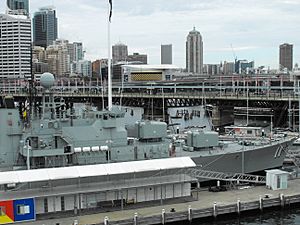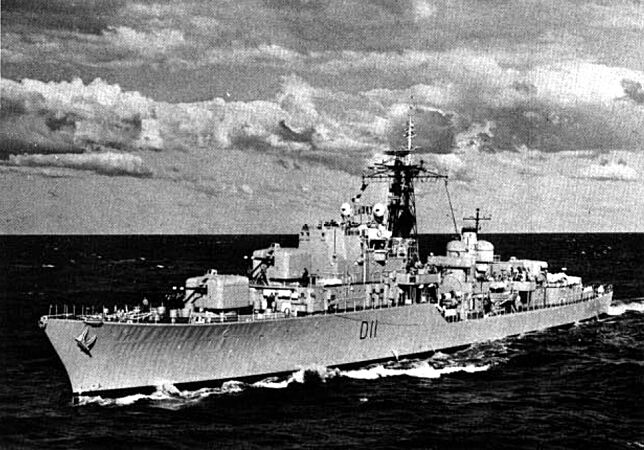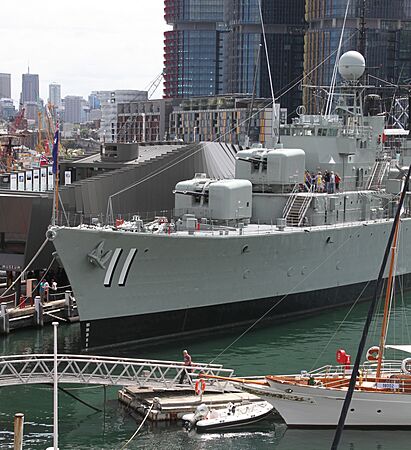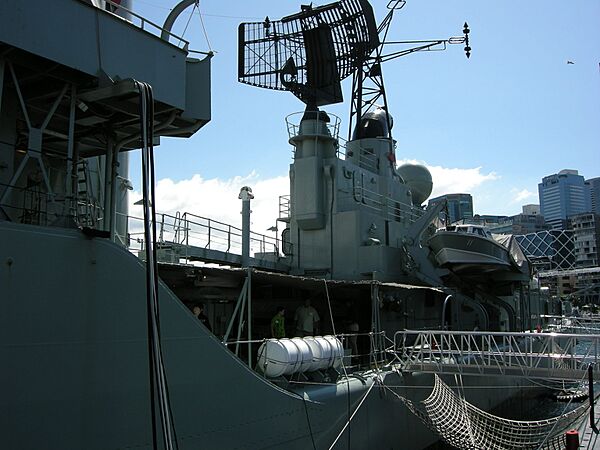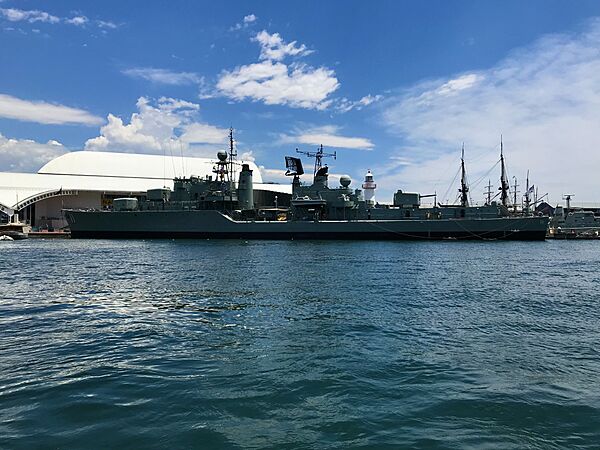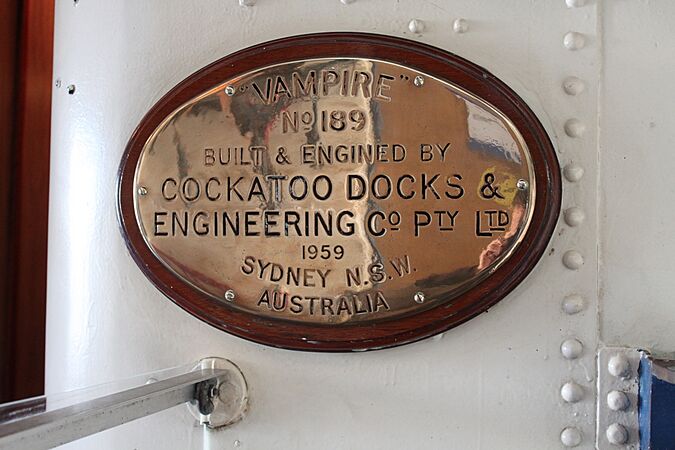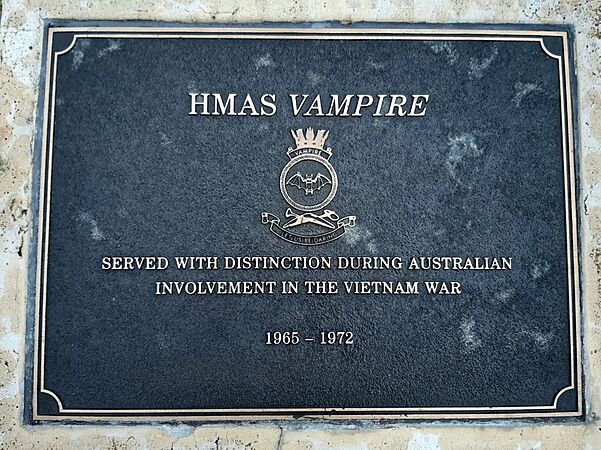HMAS Vampire (D11) facts for kids
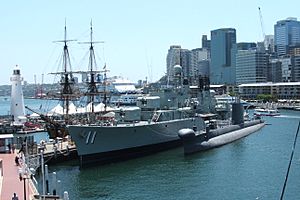
HMAS Vampire, HMAS Onslow, and the HM Bark Endeavour replica on display at the Australian National Maritime Museum
|
|
Quick facts for kids History |
|
|---|---|
| Builder | Cockatoo Island Dockyard |
| Laid down | 1 July 1953 |
| Launched | 27 October 1956 |
| Commissioned | 23 June 1959 |
| Decommissioned | 13 August 1986 |
| Reclassified | Training ship (1980) |
| Motto | "Audamus" (Latin: "Let Us Be Daring") |
| Nickname(s) |
|
| Honours and awards |
|
| Status | Preserved as museum ship |
| General characteristics | |
| Class and type | Daring-class destroyer |
| Displacement |
|
| Length | 388 ft 11.5 in (118.6 m) |
| Beam | 42 ft 11.375 in (13.1 m) |
| Draught | 12 ft 9 in (3.9 m) |
| Propulsion | 2 × Foster Wheeler boilers, English Electric geared turbines, 2 shafts, 54,000 shp (40,000 kW) |
| Speed | Over 30 knots (56 km/h; 35 mph) |
| Range | 3,700 nautical miles (6,900 km; 4,300 mi) at 20 knots (37 km/h; 23 mph) |
| Complement | 20 officers, 300 sailors |
| Sensors and processing systems |
|
| Armament |
|
HMAS Vampire was a special warship that served in the Royal Australian Navy (RAN). She was the third of three Daring class destroyers built in Australia. Vampire was one of the first ships in Australia to be built using an all-welded design. She was constructed at Cockatoo Island Dockyard between 1952 and 1959.
During her time in service, Vampire often sailed to South East Asia. She was part of the Far East Strategic Reserve five times, including during the Indonesia-Malaysia Confrontation. She also helped escort the troop transport HMAS Sydney on six trips to Vietnam. In 1977, Vampire escorted the Royal Yacht Britannia when Queen Elizabeth II and Prince Philip visited Australia. In 1980, Vampire became a training ship.
Vampire stayed in service until 1986. After being taken out of service, she became a museum ship at the Australian National Maritime Museum. She is now the largest museum object on display in Australia.
Contents
Ship Design and Features
The Royal Australian Navy first ordered four Daring class destroyers. These ships were updated during construction to make them more comfortable, like adding air-conditioning. Vampire and her sister ships were the first ships in Australia to be built entirely by welding.
The Daring class ships weighed 2,800 tons when empty and 3,600 tons when fully loaded. Vampire was about 390 feet (120 m) long, 43 feet (13 m) wide, and sat about 12 feet 9 inches (3.89 m) deep in the water. She had two powerful engines that gave her 54,000 horsepower (40,000 kW). This allowed Vampire to travel at speeds over 30 knots (56 km/h; 35 mph). She could travel 3,700 nautical miles (6,900 km; 4,300 mi) at a speed of 20 knots (37 km/h; 23 mph). Her crew usually included 20 officers and 300 sailors.
Ship's Armament
Vampire had six 4.5-inch (114 mm) guns in three twin turrets. Two turrets were at the front of the ship and one was at the back. For protection against aircraft, she had six 40-millimetre (1.6 in) Bofors guns. Four .50 in, 12.7 mm Browning machine guns were used for close-range defense. She also had five 21-inch (533 mm) torpedo tubes. For finding and attacking submarines, she carried a Limbo anti-submarine mortar. Some of these weapons, like the Bofors guns, torpedo launcher, and Limbo mortar, were removed during later updates. A Sea Cat missile system was added at one point.
Vampire used different types of sonar to detect objects underwater. These included a Type 170 for attacking, a Type 174 for searching, and a Type 185 for finding submarines. Her original fire control directors, which helped aim the guns, were replaced in 1970–71 with newer M22 units. Her air warning radar was also updated, and a radar for finding ships on the surface was installed.
Building Vampire
Vampire was started at Cockatoo Island Dockyard in Sydney, Australia, on 1 July 1952. She was officially launched into the water on 27 October 1956 by the wife of the Governor-General, Sir William Slim. The ship was finished on 22 June 1959. She officially joined the RAN in Sydney the very next day. The cost of building Vampire increased from about A£2.6 million to A£7 million during her construction.
Vampire's Service History
Early Years (1959–1970)
After joining the navy, Vampire practiced with ships from the RAN and Royal New Zealand Navy (RNZN). In March 1960, she went to Singapore as part of the Far East Strategic Reserve. She returned to Sydney in December for maintenance. Vampire won the Gloucester Cup in 1960 and 1961 for being the most efficient ship in the RAN.
In 1962, she visited Vietnam and participated in training exercises. In January 1963, Vampire began her third deployment to the Far East. She took part in the SEATO Exercise Sea Serpent. After returning to Sydney, she had more maintenance and won the Gloucester Cup again for 1963.
From October 1964 to January 1965, Vampire helped with the Commonwealth's efforts during the Indonesia-Malaysia Confrontation. She patrolled around the Malay Peninsula to stop ships from smuggling troops into Malaysia. She returned to Sydney in February 1965.
In April 1965, Vampire went to the Far East again. She escorted the aircraft carrier HMAS Melbourne during Exercise Seahorse. She also escorted the troop transport HMAS Sydney on its first trip to Vietnam.
In March 1966, Vampire started her sixth Far East deployment. She again escorted Sydney on its third trip to Vietnam. In June 1966, Vampire had a small collision with a Danish merchant ship, but she was quickly repaired. From July to August, she protected the Tawau region during the Confrontation. She used her radar to find enemy ships and sometimes provided gunfire support for ground troops.
In 1967, Vampire helped a stranded freighter. From April to May, she accompanied Sydney on its fifth and sixth troop transport trips. She visited Indonesia in September, becoming the first RAN ship to do so after the Confrontation ended. In 1969, she escorted Sydney again on its fourteenth trip to Vietnam. In April 1970, Vampire joined 45 naval ships from 13 nations in Sydney Harbour to celebrate the Australian Bicentenary.
Major Upgrade (1970–1972)
In June 1970, Vampire went to Williamstown Dockyard for a big upgrade costing $US10 million. Over 2,000 changes were made. Her radar and fire control systems were updated. Her main guns were rebuilt, and the Bofors guns were repaired. The torpedo launcher was removed. The ship's upper structure was rebuilt, and the open bridge area was enclosed. The galleys (kitchens) were modernized, and more air conditioning was added. Vampire returned to service in March 1972.
Later Service and Training Role (1972–1986)
In October 1972, Vampire was sent to Singapore for four months as part of the ANZUK force. She briefly left to escort Sydney on its twenty-fifth and final trip to Vietnam. In April 1973, she sailed to Samoa for the South Pacific Forum. In September, she took part in a training exercise off New Zealand. She was also present for the opening of the Sydney Opera House in October.
In 1974, Vampire participated in a joint exercise with Indonesia and later in Exercise Kangaroo I. She then had another eight-month refit.
In August 1975, Vampire and other ships were sent to Darwin due to tensions between Indonesia and East Timor. They were ready to help evacuate Australians if needed. In September, she began a five-month deployment, joining training exercises with US Navy ships and visiting sixteen ports for diplomatic reasons. In May 1976, Vampire visited ports along the west coast of the United States to celebrate the United States Bicentennial.
In March 1977, Vampire was chosen to escort Her Majesty's Yacht Britannia during Queen Elizabeth II and Prince Philip's visit to Australia. She escorted the royal yacht to Sydney, Melbourne, Adelaide, and Fremantle. Later that year, she was involved in rescue missions and training exercises.
In April 1979, it was announced that Vampire would become a training ship. From January to April 1980, she was refitted for this new role. Some of her radars and weapons were removed, and a training classroom was installed. After this, Vampire joined the RAN training squadron. In May, Vampire and HMAS Jervis Bay went to the Solomon Islands to watch China's first intercontinental ballistic missile test.
Becoming a Museum Ship
On 25 June 1986, Vampire finished her active service. She was officially taken out of service on 13 August 1986, after 27 years and traveling over 808,026 nautical miles (1,496,464 km). She was then given to the Australian National Maritime Museum to be preserved as a museum ship. Vampire is the largest museum object on display in Australia.
In 1991, Vampire appeared in a children's TV show called The Girl From Tomorrow Part II: Tomorrow's End. The ship is also used to train RAN divers. In 1994, two Bofors gun mounts were put back on the ship. In 1997, Vampire was allowed to fly the Australian White Ensign, even though she was no longer an active warship.
Every five years, the destroyer is towed to HMAS Kuttabul for maintenance and cleaning. During a cleaning in October 2006, a small fire broke out in the ship's boiler room. No one was hurt, and the ship was not badly damaged.
In November 2015, Vampire was moved to a new display area called 'Action Stations' at the Australian National Maritime Museum. She is now displayed alongside HMAS Onslow (HMAS Onslow) and HMAS Advance (P 83) (HMAS Advance).
Gallery
- HMAS ''Vampire'' gallery
-
HMAS Vampire sailing in the Red Sea in 1975
-
A special plaque for HMAS Vampire at Rockingham Naval Memorial Park in March 2020


